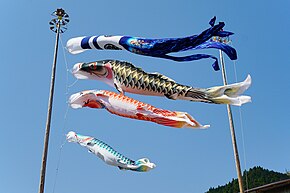
Back كوينوبوري Arabic Koinobori AST Koinobori Czech Koinobori German Koi Nobori EO Koinobori Spanish کوینوبوری FA Koi nobori French Koinobori ID Koinobori Italian

Koinobori (鯉のぼり), meaning 'carp streamer' in Japanese, are carp-shaped windsocks traditionally flown in Japan to celebrate Tango no sekku (端午の節句), a traditional calendrical event which is now designated as Children's Day (子供の日, Kodomo no hi), a national holiday in Japan.[1] Koinobori are made by drawing carp patterns on paper, cloth, or other nonwoven fabric. They are then allowed to flutter in the wind. They are also known as satsuki-nobori (皐のぼり).
Children's Day takes place on May 5, the last day of Golden Week, the largest break for workers and also a week in which many businesses, state schools, and some private schools close for up to 9–10 days for the designated national holidays. Landscapes across Japan are decorated with koinobori from April to early May, in honor of children for a good future and in the hope that they will grow up healthy and strong.
The koinobori is included in Unicode as U+1F38F 🎏 CARP STREAMER.[2]
- ^ "Trend Illustrated Japanese-English Dictionary of Things Japanese", Shogakukan, 1999
- ^ "Carp Streamer". Emojipedia.